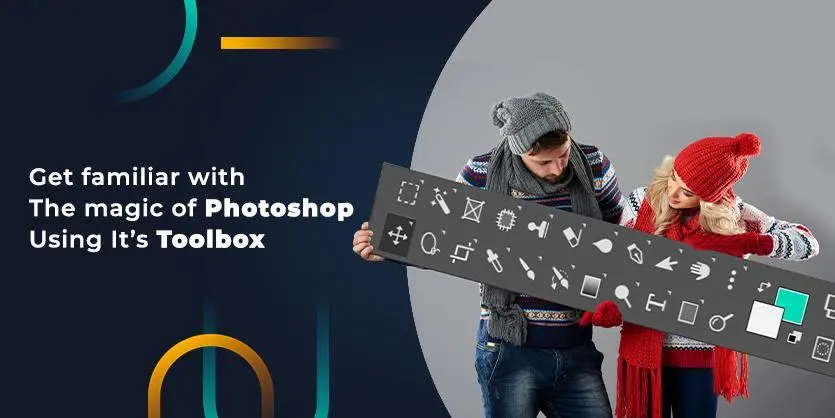Adobe Photoshop is an image retouching and image editing software that is compatible with both Windows and Mac systems. Users may use Photoshop to produce, tweak, and alter pictures, artwork, and drawings. Adobe Photoshop may be used to modify the background of a photo, mimic real-life artwork, or create a distinct view of the world. For a range of images and video file types, it is the most widely used picture editing, image alteration, and retouching software tool. Photoshop’s tools allow you to edit individual images as well as large groups of photos.
What is Photoshop Toolbox?
The essential tools for working with photos are housed in the toolbox. To choose and utilize a tool, simply click it. In both Quick and Expert modes, Photoshop Elements includes a toolbox to assist you in working with your photographs. If you’re a photographer, graphic designer, or just starting out in the field of graphics, you’ll quickly come across Photoshop. The toolbox gives you access to all of Photoshop’s tools, allowing you to perform everything from moving objects around to painting, filling with color, and generating text, among other things.
If you’re not used to it, the toolbox comprises 23 icons and roughly 73 tools, which might be confusing. Never fear: after you learn to know your way around the various tools and how they’re organized, it all starts to make sense.
Overview of the toolbox
The toolbox in Photoshop CC 2019 is seen in the screenshot below. (Other versions may have minor differences, but the general tool arrangement is the same.)
- To learn more about a tool, click its symbol or name in the image below.
- The majority of the tool icons reflect a collection of related tools. A tool group is indicated by a little black triangle in the bottom right corner of an icon. You may read descriptions of all the tools in a tool group by clicking the icon in the image below.
In the image above, the toolbox is set up in a two-column layout. By clicking the small double arrow in the upper left corner of the toolbox, you may switch between single-column and two-column format.
Each of the tools in the Photoshop toolbox is briefly described in the sections below. Some descriptions provide links to further pages with more information about the tools.
Functions of Tools in Photoshop Toolbox
There are 23 icons and 73 tools in the toolbox. Adobe Photoshop is the most widely used picture editing and alteration program. Photoshop’s toolbar is where we’ll find all the tools we’ll be utilizing. There are tools for picking photos, cutting and retouching them, adding shapes and typefaces, and a lot more! We’ll start with the toolbar itself, covering how it’s laid up and how to use the many features hidden inside it. Then we’ll go through each and every tool on the toolbar, briefly explaining what they perform. In the marketplace, It can be used for everything from full-featured picture editing to making detailed digital paintings and sketches that seem like they were done by hand.
| Tool Name | Function | Variations |
| Move Tool | Move the Objects. | 1. Move Tool2. Artboard Tool |
| Marquee Tool | Make Select your Object. | 1. Rectangular Marquee Tool2. Elliptical Marquee Tool3. Single Row Marquee Tool4. Single Column Marquee Tool |
| Lasso Tool | Make Select your Object. | 1. Lasso Tool2. Polygonal Lasso Tool3. Magnetic Lasso Tool |
| Quick Selection Tool | Make a selection with the Quick Selection tool. | 1. Quick Selection Tool2. Magic Wand Tool |
| Crop Tool | Easy to Crop your Object | 1. Crop Tool2. Perspective Crop Tool3. Slice Tool4. Slice Select Tool |
| Frame Tool | Create placeholder frames for objects. | 1. Frame Tool |
| Eyedropper Tool | The Eyedropper Tool specifies the first/secondary color. | 1. Eyedropper Tool2. 3D Material Eyedropper Tool3. Color Sampler Tool4. Ruler Tool5. Note Tool6. Count Tool |
| Spot Healing Brush Tool | Quickly removes blemishes and other imperfections in your photos. | 1. Spot Healing Brush Tool2. Healing Brush Tool3. Patch Tool4. Content-Aware Move Tool 5. Red Eye Tool |
| Brush Tool | The Brush Tool is a primary painting tool | 1. Brush ToolPencil ToolColor Replacement Tool |
| Clone Stamp Tool | It can get rid of all sorts of unwanted objects. | Clone Stamp ToolPattern Stamp Tool |
| History Brush Tool | A history brush tool restores parts of your image to a previous history . | History Brush ToolArt History Brush Tool |
| Eraser Tool | The Eraser Tool removes the unwanted pixels. | Eraser ToolBackground Eraser ToolMagic Eraser Tool |
| Gradient Tool | Makes a gradual transition between two or more colors. | Gradient ToolPrint Bucket Tool3DMaterial Drop Tool |
| Blur Tool | The Blur Tool is used to paint a blur effect. | Blur ToolSharpen ToolSmudge Tool |
| Dodge Tool | The Dodge tool lightens the areas of the photo. | 1. Dodge Tool2. Burn Tool3. Sponge Tool |
| Pen Tool | The Pen Tool in Photoshop creates paths and shapes. | 1. Pen Tool2. Freeform Pen Tool3. Content-Aware Tracing Tool4. Curvature Pen Tool5. Add Anchor Point Tool6. Delete Anchor Point Tool7. Convert Point Tool |
| Type Tool | The Type tool allows you to add text to your file. | 1. Horizontal Type Tool2. Vertical Type Tool3. Vertical Type Mask Tool4. Horizontal Type Mask Tool |
| Path Selection Tool | Used to select and move Paths. | 1. Path Selection Tool2. Direct Selection Tool |
| Shape Tool | Create vector shapes & paths. | 1. Rectangle Tool2. Rounded Rectangle Tool3. Ellipse Tool4. Polygon Tool5. Line Tool6. Custom Shape Tool |
| Hand Tool | The Hand tool allows you to move your image. | 1. Hand Tool2. Rotate View Tool |
| Zoom Tool | Used to zoom in and out of an image. | Zoom Tool |
| Edit in Quick Mask Mode | Remove unwanted objects or cut out parts of an image. | 1. Edit in Quick Mask Mode |
| Change Screen Mode | Showing or hiding and what type of background displays behind your image. | 1. Change Screen Mode |
Insights
Photoshop isn’t the easiest digital editor, but it’s the best. If you stick to the basics and put in a lot of effort, you’ll find that Photoshop can accomplish a lot of wonderful things quickly and easily, and there’s virtually nothing it can’t do.
Please leave a comment, share it, and subscribe to our site if you found this information useful. Also, if you have any questions about any aspect of graphic design, don’t hesitate to ask. We’d be delighted to hear from you and respond to any queries you might have.



